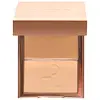Fenty Beauty Pro Filtr Soft Matte Powder Foundation Versus Patrick Ta Major Skin Crème Foundation and Finishing Powder Duo
What's inside
What's inside
 Key Ingredients
Key Ingredients

 Benefits
Benefits

 Concerns
Concerns

 Ingredients Side-by-side
Ingredients Side-by-side

Talc
AbrasiveNylon-12
Silica
AbrasivePolyester-4
Skin ConditioningSynthetic Fluorphlogopite
Zinc Stearate
Cosmetic ColorantIsoamyl Laurate
EmollientPhenyl Trimethicone
Skin ConditioningOctyldodecyl Stearoyl Stearate
EmollientPentaerythrityl Tetraisostearate
Emollient1,2-Hexanediol
Skin ConditioningCaprylyl Glycol
EmollientDimethicone
EmollientMethyl Methacrylate Crosspolymer
Phenoxyethanol
PreservativeDimethiconol
EmollientDecylene Glycol
Skin ConditioningHydrated Silica
AbrasiveTocopheryl Acetate
AntioxidantIron Oxides
CI 19140
Cosmetic ColorantTalc, Nylon-12, Silica, Polyester-4, Synthetic Fluorphlogopite, Zinc Stearate, Isoamyl Laurate, Phenyl Trimethicone, Octyldodecyl Stearoyl Stearate, Pentaerythrityl Tetraisostearate, 1,2-Hexanediol, Caprylyl Glycol, Dimethicone, Methyl Methacrylate Crosspolymer, Phenoxyethanol, Dimethiconol, Decylene Glycol, Hydrated Silica, Tocopheryl Acetate, Iron Oxides, CI 19140
Lac Powder
Skin ConditioningSilica
AbrasiveMica
Cosmetic ColorantLauroyl Lysine
Skin ConditioningZinc Stearate
Cosmetic ColorantNylon-12
Kaolin
AbrasiveOctyldodecyl Stearoyl Stearate
EmollientDimethicone
EmollientPolymethylsilsesquioxane
Polysilicone-11
Isononyl Isononanoate
EmollientMagnesium Myristate
Magnesium Ascorbyl Phosphate
AntioxidantAnthemis Nobilis Flower Water
MaskingTocopheryl Acetate
AntioxidantSodium Benzoate
MaskingPotassium Sorbate
PreservativeCaprylyl Glycol
EmollientPhenoxyethanol
PreservativeCitric Acid
BufferingHexylene Glycol
EmulsifyingLaureth-12
EmulsifyingTriethoxycaprylylsilane
CI 77891
Cosmetic ColorantCI 77491
Cosmetic ColorantPPG-3 Benzyl Ether Myristate
EmollientEthylhexyl Isononanoate
EmollientDivinyldimethicone/Dimethicone/Phenylsilsesquioxane Crosspolymer
Polyethylene
AbrasivePentaerythrityl Tetraisostearate
EmollientBis-Stearyl Dimethicone
EmollientButyl Acrylate/Hydroxypropyl Dimethicone Acrylate Copolymer
Ethylhexyl Palmitate
EmollientIsopropyl Myristate
EmollientLecithin
EmollientPolyhydroxystearic Acid
EmulsifyingPolyglyceryl-10 Polyricinoleate
EmulsifyingPentaerythrityl Tetra-Di-T-Butyl Hydroxyhydrocinnamate
AntioxidantIsostearic Acid
CleansingLac Powder, Silica, Mica, Lauroyl Lysine, Zinc Stearate, Nylon-12, Kaolin, Octyldodecyl Stearoyl Stearate, Dimethicone, Polymethylsilsesquioxane, Polysilicone-11, Isononyl Isononanoate, Magnesium Myristate, Magnesium Ascorbyl Phosphate, Anthemis Nobilis Flower Water, Tocopheryl Acetate, Sodium Benzoate, Potassium Sorbate, Caprylyl Glycol, Phenoxyethanol, Citric Acid, Hexylene Glycol, Laureth-12, Triethoxycaprylylsilane, CI 77891, CI 77491, PPG-3 Benzyl Ether Myristate, Ethylhexyl Isononanoate, Divinyldimethicone/Dimethicone/Phenylsilsesquioxane Crosspolymer, Polyethylene, Pentaerythrityl Tetraisostearate, Bis-Stearyl Dimethicone, Butyl Acrylate/Hydroxypropyl Dimethicone Acrylate Copolymer, Ethylhexyl Palmitate, Isopropyl Myristate, Lecithin, Polyhydroxystearic Acid, Polyglyceryl-10 Polyricinoleate, Pentaerythrityl Tetra-Di-T-Butyl Hydroxyhydrocinnamate, Isostearic Acid
 Reviews
Reviews

Ingredients Explained
These ingredients are found in both products.
Ingredients higher up in an ingredient list are typically present in a larger amount.
Caprylyl Glycol is a humectant and emollient, meaning it attracts and preserves moisture.
It is a common ingredient in many products, especially those designed to hydrate skin. The primary benefits are retaining moisture, skin softening, and promoting a healthy skin barrier.
Though Caprylyl Glycol is an alcohol derived from fatty acids, it is not the kind that can dry out skin.
This ingredient is also used as a preservative to extend the life of products. It has slight antimicrobial properties.
Learn more about Caprylyl GlycolDimethicone is a type of synthetic silicone created from natural materials such as quartz.
What it does:
Dimethicone comes in different viscosities:
Depending on the viscosity, dimethicone has different properties.
Ingredients lists don't always show which type is used, so we recommend reaching out to the brand if you have questions about the viscosity.
This ingredient is unlikely to cause irritation because it does not get absorbed into skin. However, people with silicone allergies should be careful about using this ingredient.
Note: Dimethicone may contribute to pilling. This is because it is not oil or water soluble, so pilling may occur when layered with products. When mixed with heavy oils in a formula, the outcome is also quite greasy.
Learn more about DimethiconeNylon-12 is a polymer. It is derived from 12-aminododecanoic acid, an omega-amino fatty acid
According to a manufacturer, it is a talc substitute. Like talc, nylon-12 gives products a satin feel. The manufacturer also claims this ingredients does not block pores and has moderate oil absorption.
This ingredient may not be reef-safe.
Learn more about Nylon-12Octyldodecyl Stearoyl Stearate is created from stearic acid.
It is an emollient and thickens the lipid (oil) portion of a product. Due to its emollient properties, it may not be fungal-acne safe.
Pentaerythrityl Tetraisostearate is derived from isostearic acid. It is an emollient and emulsifier.
The highest concentration of this ingredient is found in lipsticks.
This ingredient is minimally water soluble and may not be Malassezia folliculitis, or fungal-acne safe.
Learn more about Pentaerythrityl TetraisostearatePhenoxyethanol is a preservative that has germicide, antimicrobial, and aromatic properties. Studies show that phenoxyethanol can prevent microbial growth. By itself, it has a scent that is similar to that of a rose.
It's often used in formulations along with Caprylyl Glycol to preserve the shelf life of products.
Silica, also known as silicon dioxide, is a naturally occurring mineral. It is used as a fine, spherical, and porous powder in cosmetics.
Though it has exfoliant properties, the function of silica varies depending on the product.
The unique structure of silica enhances the spreadability and adds smoothness, making it a great texture enhancer.
It is also used as an active carrier, emulsifier, and mattifier due to its ability to absorb excess oil.
In some products, tiny microneedles called spicules are made from silica or hydrolyzed sponge. When you rub them in, they lightly polish away dead skin layers and enhance the penetration of active ingredients.
Learn more about SilicaTocopheryl Acetate is AKA Vitamin E. It is an antioxidant and protects your skin from free radicals. Free radicals damage the skin by breaking down collagen.
One study found using Tocopheryl Acetate with Vitamin C decreased the number of sunburned cells.
Tocopheryl Acetate is commonly found in both skincare and dietary supplements.
Learn more about Tocopheryl AcetateZinc Stearate is the metal salt of stearic acid. It is a white solid used to bind, thicken, and lubricate products.
This ingredient is common in powder makeup, where it helps keep the powder together.
Zinc Stearate is hydrophobic and repels water.
This ingredient can be sourced from non-animal or animal sources. It is best to reach out to the brand to see where they source this ingredient from.
Learn more about Zinc Stearate